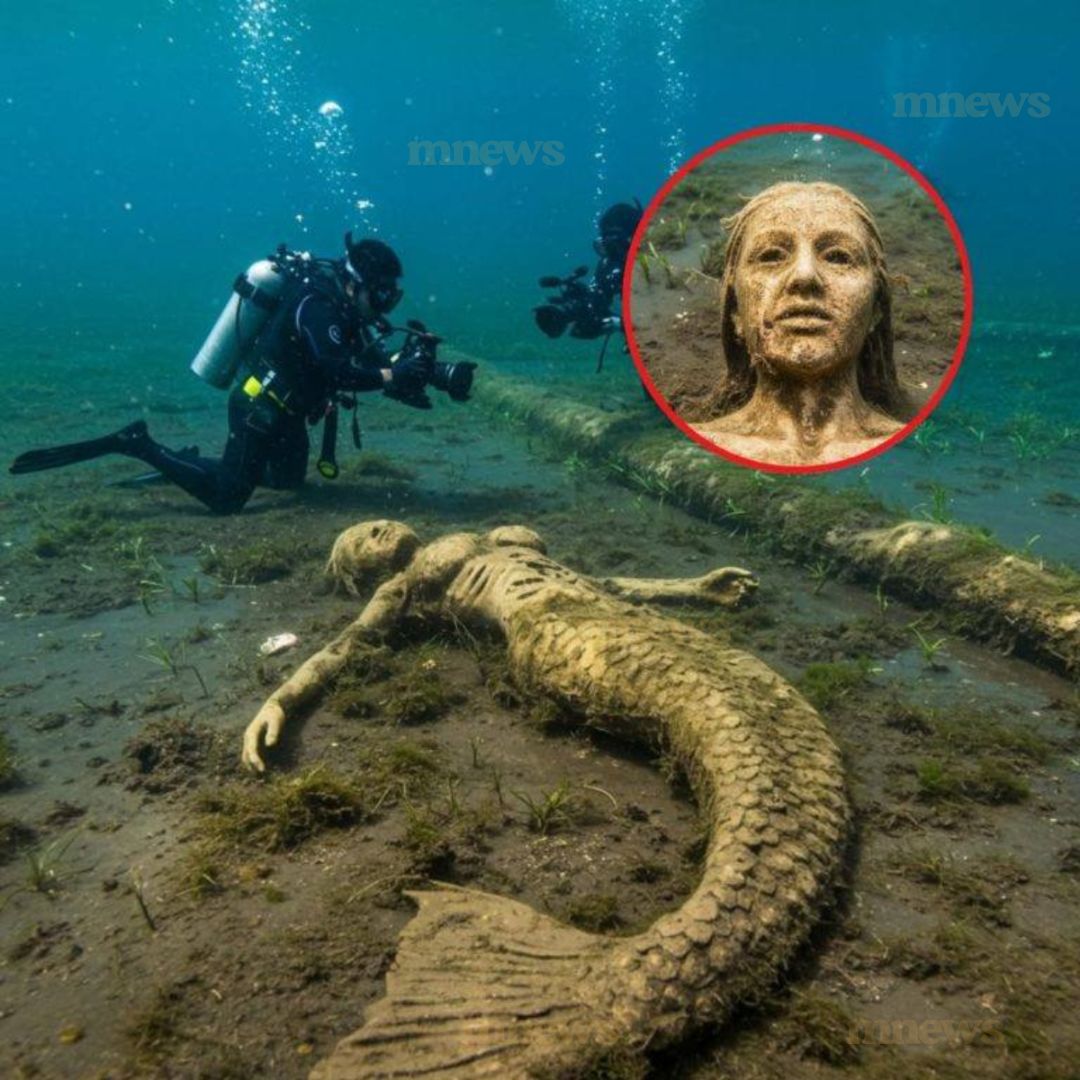An Unbelievable Discovery Raises Questions About Evolution, Myth, and Global Secrecy

1. The Discovery That Shook the Deep
It began with what seemed like a routine deep-sea exploration off the coast of Okinawa, Japan — an area already famous among marine biologists for its unusual biodiversity and mysterious underwater rock formations. On October 28th, 2025, a privately funded dive team known as Blue Abyss Exploration Unit reported encountering a figure buried beneath centuries of coral and volcanic sediment, at a depth of more than 3,000 meters.
At first, they believed they had found the remains of an ancient marine mammal — perhaps a monk seal or a large dolphin. But when one of the divers brushed away the silt, what they saw made their blood run cold: a humanoid torso, complete with arms, rib cage, and what looked unmistakably like strands of hair still attached to a skull with eerily human features.
Lead diver Hiroshi Tanaka, a veteran with over two decades of deep-sea expeditions, recalled in a trembling voice during a later interview:
“It wasn’t a fish. It wasn’t a seal. The upper body looked human — even feminine — but the lower half was something else. Scales, fins… a tail. It was like the body was trying to decide whether it belonged to the sea or the land.”
The team’s cameras captured footage — though only short fragments have been publicly leaked — showing a preserved figure approximately 1.7 meters long, half-embedded in coral. Its tail was covered in iridescent scales resembling those of deep-sea anglerfish, but its torso, hands, and face appeared disturbingly human. The hands were slender, with five digits and what looked like webbing between them.
Within hours of the discovery, satellite data reportedly showed an unidentified naval vessel approaching the area, prompting the divers to retreat. By the following day, their coordinates had mysteriously vanished from marine databases.
2. Initial Analysis: Anatomy of the Impossible
Two days after the find, samples of the surrounding sediment — and allegedly a small tissue fragment — were handed over to a private lab in Kyoto. The lab’s report, leaked to the Japanese news site Ocean Secrets, described something “biologically inconsistent with any known species on Earth.”
The tissue, according to the document, contained a mixture of human mitochondrial DNA and unidentified marine genetic markers, unlike any sequence cataloged in global DNA databases. Some scientists dismissed the results as contamination, but others, including Professor Amelia Roth from the University of Oslo’s Department of Evolutionary Biology, said the findings “challenge our very definition of what it means to be human.”
“If these results are genuine,” Professor Roth told reporters, “then we are looking at a lineage that diverged from hominids over tens of thousands of years ago — perhaps an offshoot that adapted to aquatic environments.”
CT scans performed on partial remains showed bones similar to a human rib cage, yet fused structures in the pelvis — possibly adaptations for swimming. The lower body exhibited vertebral extensions resembling those of cetaceans, and a powerful caudal fin that seemed biologically functional rather than decorative.
One particularly haunting detail emerged: the face.
Unlike marine creatures with lateral eyes, the mummy’s orbits faced forward — a distinctly human trait. Eyelids, though shriveled, were still visible. And on the lips — which had receded with time — faint traces of keratin tissue were detected, suggesting the creature once breathed air.
Was it possible? A mermaid, not a myth, but a species — a forgotten branch of evolution?
3. The Media Frenzy and Government Denial
Within 72 hours, global media platforms erupted. Hashtags like #MermaidMummy and #OkinawaSiren trended across Twitter, TikTok, and Reddit. The leaked images — grainy, with timestamps obscured — drew both fascination and skepticism. Skeptics called it “a hoax in the tradition of the Fiji Mermaid,” but others pointed out that the footage showed no sign of digital manipulation.
Then came the silence.
Blue Abyss Exploration Unit released one official statement before all their online profiles were taken down:
“We have been instructed to withhold further information in the interest of national and ecological security.”
Shortly afterward, Japan’s Maritime Self-Defense Force issued a bland press release claiming “no unidentified biological entities” were discovered. Yet satellite imagery revealed naval vessels still stationed in the same area for weeks afterward.
Anonymous sources later told The Atlantic Ledger that a “special biological containment unit” from the U.S. Navy had transferred the specimen to a classified research facility in Guam under the code name Project NEPTUNE-11. The Pentagon refused to comment, saying only: “We have no record of such an operation.”
4. The Science Behind the Myth — or the Myth Behind the Science?
Scientists worldwide have long debated the possibility of aquatic humanoids — a theory once dismissed as pseudoscience. But recent studies of early hominid fossils found near ancient shorelines have reignited interest in the so-called Aquatic Ape Hypothesis, which suggests that certain human ancestors adapted to marine environments.
Dr. Leonardo Mbeki, marine biologist at the University of Cape Town, believes the Okinawa mummy could provide missing evidence:
“Look at our physiology — the way human infants instinctively hold their breath underwater, the layer of subcutaneous fat, our ability to shed salt through tears and sweat. We may have deeper evolutionary ties to the ocean than we realize.”
Other experts point to folklore alignment. Ancient Sumerian tablets depict Oannes, a half-man, half-fish teacher said to emerge from the sea to bring wisdom to humanity. Celtic legends mention Selkies, shape-shifting sea women. In Japanese mythology, the Ningyo — a fish-human hybrid — was believed to bring longevity or disaster.
Could these myths have been distorted memories of real encounters with an aquatic species that once coexisted with humans?
A recently declassified report from the Soviet Navy (1977) describes encounters with “aquatic humanoids” in Lake Baikal — silver-skinned, breathing underwater without equipment, swimming at impossible speeds. The Soviet divers who reported them later died mysteriously.
Now, with the Okinawa mummy, such stories no longer seem entirely absurd.
5. Leaked Photos and the Social Media Storm
In early November, three high-resolution photos surfaced on the dark web, showing what appears to be a preserved figure in a cryogenic chamber. The images, allegedly leaked from a U.S. military transport file, were analyzed by independent journalists and found to be free of digital tampering.
The body in the photos appears female, with long, fibrous strands resembling hair, a skeletal structure visible beneath translucent skin, and a tail extending from the hips covered in pale blue scales. One image even shows the label “N-11-M SPECIMEN – PROPERTY OF U.S. GOVT.”
The internet exploded.
Some hailed it as the greatest discovery in human history. Others warned of manipulation, arguing it could be a test subject from genetic experiments. Conspiracy theorists linked the event to deep-sea drilling projects or ancient alien DNA splicing, suggesting humanity’s myths may have extraterrestrial roots.
TikTok videos analyzing the “mermaid’s eyes” amassed over 400 million views in three days. Scientists begged for calm, but the public wanted answers.
6. Expert Dissection — The “Atlantis Connection”
A team of independent researchers led by Dr. Marcus Laine, a paleo-anthropologist from Helsinki, attempted to reconstruct the evolutionary lineage of the creature using comparative anatomy. Their 78-page paper, published briefly before being mysteriously retracted, concluded that the specimen may represent a transitional hybrid species — Homo aquatilis.
Their report cited the following anomalies:
-
Gills-like slits on the neck region, though sealed by skin layers — suggesting vestigial organs.
-
Extra cartilage in the ear canal, similar to adaptations in marine mammals.
-
A dual respiratory structure, capable of switching between air and dissolved oxygen absorption.
-
Increased melanin and reflective tissue under the skin, providing camouflage in deep water.
What shocked readers most was the brain size: estimated cranial volume of 1,450 cubic centimeters — nearly identical to modern humans. Meaning: intelligence was not only possible, but likely.
Dr. Laine’s paper also mentioned inscriptions carved into nearby coral stones — symbols matching those found in underwater ruins near Yonaguni, often theorized to be remnants of Atlantis-like civilizations. The possibility that these beings had once interacted with early humans now hovered between science and forbidden archaeology.
Within 48 hours of publication, the paper vanished from academic servers. Dr. Laine’s social accounts were deleted. His university declined to comment.
7. Whispers of a Cover-Up
Whistleblowers have since come forward, claiming the Okinawa mummy was just one of several discoveries over the past decade, all quietly classified. One anonymous insider from an “international oceanic defense task force” stated that multiple humanoid remains were recovered between 2014 and 2023 — from the Caribbean trench, the Baltic Sea, and the Philippine basin — each confiscated within days.
“They don’t want the public to know,” the whistleblower said.
“Because if this creature existed, it would rewrite everything — religion, history, evolution, even national security.”
Rumors claim the mermaid’s DNA sequencing revealed gene structures resistant to radiation and rapid tissue regeneration, prompting pharmaceutical and military interest. One leaked memo mentioned “bio-adaptation technology with potential for human enhancement.”
Meanwhile, major world religions have reacted cautiously. The Vatican reportedly requested access to the specimen but was denied. The Dalai Lama released a statement urging compassion “for all sentient beings, land or sea.” The United Nations proposed forming an ethics committee on “aquatic sentient discovery,” though the proposal quietly disappeared from the agenda.
8. The Sound Beneath the Silence
On December 2nd, oceanographic stations in the Pacific recorded a deep, resonant sound at 3,200 meters — described as “organic yet structured.” Some claimed it resembled a song. Audio analysis revealed frequency modulations similar to human vocalization patterns, though stretched over longer intervals.
Researchers nicknamed it The Siren Call.
Was it a coincidence — or a response?
Could others of its kind still exist in the abyss, calling out for their lost sister now entombed in glass?
NASA’s oceanic division (yes, NASA quietly monitors oceanic acoustics) released a brief statement saying the sound was “geothermal in origin.” But internal memos leaked later that week showed transcripts labeled: UNIDENTIFIED BIO-ACOUSTIC SIGNAL – PARALLEL TO HUMAN SPEECH RANGE.
9. A World on the Edge of Revelation
As 2025 draws to a close, the discovery of the mummified mermaid continues to polarize the scientific community. Universities demand transparency. Citizens demand proof. And yet, the silence from official institutions only deepens the mystery.
Some speculate the world is being slowly prepared for disclosure — not about aliens from the stars, but civilizations beneath our own oceans. If intelligent aquatic species evolved alongside humanity, then myths of mermaids, sea gods, and undersea empires may not be fantasies at all — but fragmented memories of real encounters lost to time.
Underneath the waves lie 95% of the ocean still unexplored. As one anonymous researcher wrote in a cryptic email leak:
“We keep searching the skies for answers. Maybe the real aliens have been below us all along.”
10. Conclusion: Between Myth and Memory
In the end, the “Mummified Mermaid of Okinawa” remains locked behind classified doors — part fossil, part forbidden truth. Whether hoax, hybrid, or herald of a lost species, its discovery has ignited the imagination of billions. It forces humanity to confront a haunting question: What if evolution didn’t stop with us?
When the ocean calls again, will we be ready to listen — or will we bury its voice once more beneath the silence of fear and disbelief?
The sea, after all, remembers everything.
And somewhere in its endless dark, something ancient may still be watching.





